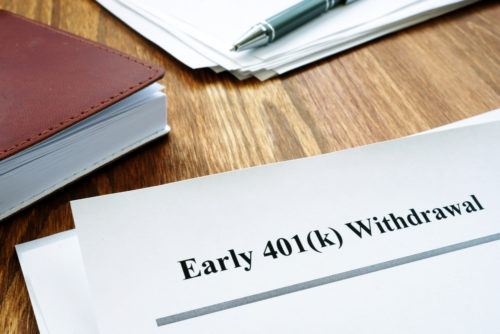A 401(k) is a retirement savings plan that allows you to contribute a portion of your income into an account that earns investment income. In some cases, your employer may choose to match your contribution. Most of the time you are not able to withdraw from your 401(k) retirement plan until you’ve retired. However, some plans allow 401(k) hardship withdrawals.
If you need a large amount of money, a hardship withdrawal from your 401(k) account may be the answer. You will need to provide the IRS with proof of your hardship in order to remove funds from your account. There are many ways a person can demonstrate financial hardship to the IRS so that they can access the funds in their 401(k) retirement account.
Learn more about how to demonstrate a hardship to the IRS and withdraw funds from your 401(k).
Table of Contents
401(k) Hardship Withdrawal Criteria
You must demonstrate an immediate and heavy financial need to take money out of your retirement account. Some of the most common reasons of hardship include:
- Unexpected medical expenses.
- Costs related to the purchase of a home, excluding mortgage payments.
- Emergency expenses related to damage to your primary residence.
- Tuition costs.
- Payments that are necessary to prevent eviction or foreclosure on a property.
- Burial or funeral expenses.
To withdraw a hardship disbursement from your 401(k), you must meet additional criteria, including presenting the IRS with proof of your hardship.
Proof of Hardship
In order to qualify for a hardship, you must provide the IRS with an explanation of your situation. If your 401(k) plan allows for hardship distributions, the plan will specify the information you need to supply to demonstrate your hardship.
Typically, the “deemed necessary” rules apply in these situations, but your employer may also reply to your representation of hardship. In any case, the IRS states that your employer cannot rely on your representation if they have knowledge that your need for financial help can be relieved through:
- Insurance reimbursement or compensation.
- Liquidation of your assets.
- Ceasing elective contributions.
- Other distributions, like plan loans, provided by any employer.
- Borrowing from commercial entities.
How Much Can You Borrow?
When borrowing from your 401(k), you can’t just borrow any old amount. Most often, you can only borrow the amount that is necessary to satisfy your financial needs. You can borrow 50% of your vested account balance or $50,000 — whichever is less. In the case where you only have $10,000 or less in your 401(k) account at the time of your demonstrated need, you can borrow up to $10,000.
Taxes on 401(k) Hardship Withdrawal
Taxes are required to be paid on the amount that you borrow. You are subject to income tax, as well as an additional 10% tax. This tax is the IRS penalty fee for withdrawing money before you are 59½ years old. In most cases, these taxes and fees are detrimental to the funds in your retirement account.
Before You Take a Hardship Withdrawal
Before you take money out of your 401(k) as a hardship withdrawal, it’s important to know that your 401(k) money is protected from creditors and protected from bankruptcy. This means your contributions can’t be seized — they remain yours no matter what.
If you’re currently experiencing financial hardship, you may want to consider borrowing money from a bank or other lender rather than withdrawing from your 401(k). There are a number of other ways you can get funding for your hardship, including personal loans, which often come with decent interest rates and repayment terms.
Other Ways to Get Your 401(k) Money
If you are at least 59 ½ years old, you are permitted to withdraw from your funds without receiving a penalty. You may also receive funds from your 401(k) retirement account if they are being taken out for reasons the IRS deems suitable, including:
- A financial correction.
- Death or permanent disability.
- Court orders that state funds be paid out to a dependent.
- Matters that relate to divorce as ordered by the court.
- Medical expenses that exceed 10% of your adjusted gross income.
- Disasters that the IRS grants relief for.
- Qualified active military service.
After You Take a Hardship Withdrawal
Once you take money from your 401(k) as a hardship withdrawal, you will not be able to make contributions to your 401(k) plan for six months afterward. Additionally, you don’t have to pay back the amount you withdraw. Once the six months are over, you can continue to make regular contributions to your 401(k) plan.
Before you take money out of your 401(k) retirement fund as a hardship withdrawal, it’s important to consider all of the pros and cons associated with doing so. Taking this money out prior to age 59½ can destroy the financial planning you’ve set in place for your retirement.
Image Source: https://depositphotos.com/





